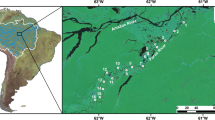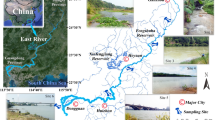Abstract
Floodplain rivers worldwide are threatened by loss of connectivity to their floodplains and hence reduced benefits from floodplain energy subsidies. Dryland rivers with ‘boom and bust’ ecological responses to flooding and extended dry periods may be particularly vulnerable. This paper describes variations in dietary composition of three fish species of contrasting trophic position in dryland floodplain lagoons with variable flood inundation and drying histories. The study species were Ambassis agassizii - a microphagic carnivore, Leiopotherapon unicolor - a carnivore/omnivore, and Nematalosa erebi - an algivore/detritivor. Despite the range of food items recorded in fish guts, each species fed mostly on relatively few food categories and few food items within each category. Most of the spatial (i.e. among lagoons) and temporal dietary variation was associated with different proportional contributions of these food items. Given the absence or low magnitude of flooding during the study period, temporal changes in diets of the three species are probably the result of successional changes in composition of invertebrate prey as the dry season progressed. The focus of each fish species on relatively few food categories and a few reliable food items within each category may be the most profitable foraging strategy when food resources are limiting in progressively drying floodplain lagoons.





Similar content being viewed by others
References
Arthington AH (1992) Diets and trophic guild structure of freshwater fishes in Brisbane streams. Proc R Soc Qld 102:31–47
Arthington AH, Balcombe SR (2011) Extreme hydrologic variability and the boom and bust ecology of fish in arid-zone floodplain rivers: a case study with implications for environmental flows, conservation and management. Ecohydrology 4:708–720
Arthington AH, Balcombe SR, Wilson GA, Thoms MC, Marshall JC (2005) Spatial and temporal variation in fish-assemblage structure in isolated waterholes during the 2001 dry season of an arid-zone floodplain river, Cooper Creek, Australia. Marine Freshw Res 56:25–35
Atkins B (1984) Feeding ecology of Nematolosa erebi in the lower River Murray. Honors Thesis, University of Adelaide
Balcombe SR, Bunn SE, Davies PM, McKenzie-Smith FJ (2005) Variability of fish diets between dry and flood periods in an arid zone floodplain river. J Fish Biol 67:1552–1567
Balcombe SR, Bunn SE, Arthington AH, Fawcett JH, McKenzie-Smith FJ, Wright A (2007) Fish larvae, growth and biomass relationships in an Australian arid zone river: links between floodplains and waterholes. Freshw Biol 52(12):2385–2398
Bass JAB, Pinder LCV, Leach DV (1997) Temporal and spatial variation in zooplankton populations in the river Great Ouse: an ephemeral food resource for larval and juvenile fish. Regul Rivers: Res Manag 13:245–258
Biondini ME, Bonham CD, Redente EF (1985) Secondary successional patterns in a sagebrush (Artemisia tridentata) community as they relate to soil disturbance and soil biological activity. Vegetatio 60(1):25–36
Bishop KA, Allen SA, Pollard DA, Cook MG (2001) Ecological studies on the freshwater fishes of the Alligator Rivers Region, Northern Territory: autecology. Supervising Scientist. Environment Australia. Department of the Environment and Heritage, Darwin, p 570
Blessing JJ, Marshall JC, Balcombe SR (2010) Humane killing of fishes for scientific research: a comparison of two methods. J Fish Biol 76(10):2571–2577
Bunn SE, Boon PI (1993) What sources of organic carbon drive food webs in billabongs? A study based on stable isotope analysis. Oecologia 96:85–94
Bunn SE, Davies PM, Winning M (2003) Sources of organic carbon supporting the food web of an arid zone floodplain river. Freshw Biol 48:619–635
Bunn SE, Thoms MC, Hamilton SK, Capon SJ (2006) Flow variability in dryland rivers: boom, bust and the bits in between. River Res Appl 22:179–186
Burford M, Cook A, Fellows CS, Balcombe SR, Bunn SE (2008) Sources of carbon fuelling production in an arid floodplain river. Marine Freshw Res 59:224–234
Butcher R (1997) Marshes, swamps and billabongs - bugs love ’em. Watershed October: 3–5
Day JA, Davies BR (1986) The Amazon river system. In: Davies BR, Walker KF (eds) The ecology of river systems. Dr. W. Junk Publishers, Dordrecht, pp 289–318, 793 pp
Geddes MC, Puckridge JT (1989) Survival and growth of larval and juvenile native fish. The importance of the floodplain. In: Murray-Darling Basin Commission (ed) Proceedings of the Workshop on Native Fish Management, Canberra, 16–17 June, 1988. Murray-Darling Basin Commission, Canberra, pp 101–115, 174 pp
Gehrke PC (1988) Influence of gut morphology, sensory cues and hunger on feeding behaviour of spangled perch, Leiopotherapon unicolor (Gunther, 1859), (Percoidei, Terapontidae). J Fish Biol 33:189–201
Hamilton SK, Bunn SE, Thoms MC, Marshall JC (2005) Persistence of aquatic refugia between flow pulses in a dryland river system (Cooper Creek, Australia). Limnol Oceanogr 50:743–754
Hillman TJ (1995) Billabongs, floodplains and the health of rivers. Water May/June:16–19
Hillman T (1998) River-billabong interactions: the links that keep our rivers healthy. Watershed 22(7):4–5
Hyslop EJ (1980) Stomach contents analysis - a review of methods and their application. J Fish Biol 17(4):411–429
Jenkins KM, Boulton AJ (2003) Connectivity in a dryland river: short-term aquatic microinvertebrate recruitment following floodplain inundation. Ecology 84(10):2708–2723
Jepsen DB, Winemiller KO (2002) Structure of tropical river food webs revealed by stable isotope ratios. Oikos 96:46–55
Junk WJ, Bayley PB, Sparks RE (1989) The flood pulse concept in river-floodplain systems. In: Dodge DP (Ed) Proceedings of the International Large Rivers Symposium. Canadian Special Publication of Fisheries and Aquatic Sciences. Ottawa. 106 pp, p 110–127
Kingsford RT, Curtin AL, Porter JL (1999) Water flows on Cooper Creek in arid Australia determine “boom” and “bust” periods for waterbirds. Biol Conserv 88:231–248
Kingsford RT, Lemly AD, Thompson JR (2006) Impacts of dams, river management and diversions on desert rivers. In: Kingsford RT (ed) Ecology of desert rivers. Cambridge University Press, Melbourne, pp 203–247
Marchant R (1982) Seasonal variation in the macroinvertebrate fauna of billabongs along Magela Creek, Northern Territory. Aust J Marine Freshw Res 33:329–342
Marshall S, Elliott M (1997) A comparison of univariate and multivariate numerical and graphical techniques for determining inter- and intraspecific feeding relationships in estuarine fish. J Fish Biol 51:526–545
Marshall JC, Sheldon F, Thoms M, Choy S (2006) The macroinvertebrate fauna of an Australian dryland river: spatial and temporal patterns and environmental relationships. Marine Freshw Res 57(1):61–74
McCune B, Grace JB (2002) Analysis of ecological communities. MjM Software Design, Gleneden Beach, Oregon, USA
McCune B, Mefford MJ (1999) PC-ORD. Multivariate analysis of ecological data, Version 4.27 edn. MjM Software Design, Gleneden Beach, Oregon, U.S.A
McDowall RM (ed) (1996) Freshwater fishes of south‐eastern Australia. Reed, Chatswood
Medeiros ESF, Arthington AH (2008a) Diel variation in food intake and diet composition of three native fish species in floodplain lagoons of the Macintyre River, Australia. J Fish Biol 73(4):1024–1032
Medeiros ESF, Arthington AH (2008b) The importance of zooplankton in the diets of three native fish species in floodplain waterholes of a dryland river, the Macintyre River, Australia. Hydrobiologia 614:19–31
Medeiros ESF, Arthington AH (2011a) Allochthonous and autochthonous carbon sources for fish in floodplain lagoons of an Australian dryland river. Environ Biol Fishes 90:1–17
Medeiros ESF, Arthington AH (2011b) Flood inundation and the temporal dynamics of floodplain waterholes in an Australian dryland river. In: Álvarez MA (ed) Floodplains: physical geography. Ecology and societal interactions. Nova Science Publishers, Inc., New York, pp 127–177
Merrick JR, Schmida GE (1984) Australian freshwater fishes: biology and management. North Ryde, N.S.W
Morton SR, Short J, Barker RD (1995) Refugia for biological diversity in arid and semi-arid Australia. Biodiversity Series, Paper no 4. Report to the Biodiversity Unit of the Department of Environment, Sport and Territories, Canberra, Australia, p 171 pp
Pusey BJ, Read MG, Arthington AH (1995) The feeding ecology of freshwater fishes in two rivers of the Australian wet tropics. Environ Biol Fishes 43(1):85–103
Pusey BJ, Arthington AH, Read MG (2000) The dry-season diet of freshwater fishes in monsoonal tropical rivers of Cape York Peninsula, Australia. Ecol Freshw Fish 9(3):177–190
Pusey BJ, Kennard MJ, Arthington AH (2004) Freshwater fishes of north‐eastern Australia. CSIRO Publishing, Melbourne
Rodriguez MA, Lewis WM Jr (1997) Structure of fish assemblages along environmental gradients in floodplain lakes of the Orinoco River. Ecol Monogr 67:109–128
Saint-Paul U et al (2000) Fish communities in central Amazonia white- and blackwater floodplains. Environ Biol Fishes 57:235–250
Schafer LN, Platell ME, Valesini FJ, Potter IC (2002) Comparisons between the influence of habitat type, season and body size on dietary compositions of fish species in nearshore marine waters. J Exp Marine Biol Ecol 278:67–92
Sheldon F, Boulton AJ, Puckridge JT (2002) Conservation value of variable connectivity: aquatic invertebrate assemblages of channel and floodplain habitats of a central Australian arid-zone river, Cooper Creek. Biol Conserv 103(1):13–31
Sheldon F, Boulton AJ, Puckridge JT (2003) Variable hydrological connection structures aquatic invertebrate composition in dryland rivers: data from Cooper Creek and Diamantina River. Rec S Aust Mus 7:119–130
Sternberg D, Balcombe S, Marshall J, Lobegeiger J (2008) Food resource variability in an Australian dryland river: evidence from the diet of two generalist native fish species. Marine Freshw Res 59:137–144
Tockner K, Bunn SE, Gordon C, Naiman RJ, Quinn GP, Stanford JA (2008) Flood plains: critically threatened ecosystems. In: Polunin NVC (ed) Aquatic ecosystems. Cambridge University Press, Cambridge, pp 45–61
Tockner KA, Lorang MS, Stanford JA (2010) River flood plains are model ecosystems to test general hydrogeomorphic and ecological concepts. River Res Appl 26:76–86
Welcomme RL (1985) River fisheries. FAO Fish. Tech. Pap. No. 262, Rome
Welcomme RL et al (2006) Predicting the water requirements of river fisheries. In: Verhoeven JTA, Beltman B, Bobbink R, Whigham DF (eds) Wetlands and natural resource management. Ecological Studies, vol 190. Springer, Berlin, pp 123–154
Werner EE, Gilliam JF (1984) The ontogenetic niche and species interactions in size-structured populations. Annu Rev Ecol Syst 15:393–425
Winemiller KO (1989) Ontogenetic diet shifts and resource partitioning among piscivorous fishes in the Venezuelan ilanos. Environ Biol Fishes 26:177–199
Winemiller KO (1996) Factors driving temporal and spatial variation in aquatic floodplain food webs. In: Polis GA, Winemiller KO (eds) Food webs: integration of patterns and dynamics. Chapman and Hall, New York, pp 298–312, 472 pp
Winemiller KO, Jepsen DB (1998) Effects of seasonality and fish movement on tropical river food webs. J Fish Biol 53(suppl A):267–296
Wissmar RC, Richey JE, Stallard RF, Edmond JM (1981) Plankton metabolism and carbon processes in the Amazon River, its tributaries, and floodplain waters, Peru-Brazil, May–June 1977. Ecology 62:1622–1633
Zaret TM, Rand AS (1971) Competition in tropical stream fishes: support for the competitive exclusion principle. Ecology 52(2):336–342
Acknowledgments
The authors are grateful to Griffith University and the CRC for Freshwater Ecology for financial and logistic support during the course of this research, and the Brazilian Agency for Post-Graduate Education (CAPES) for a post-graduate scholarship to Elvio Medeiros (BEX 1475/99-1). The authors also thank Glenn Wilson (formerly located at the Northern Basin Laboratory, Murray-Darling Freshwater Research Centre, Goondiwindi) for his support during field aspects of this study. Fish were collected under Queensland and New South Wales Fisheries Permit Nos. PRM00234H, PRM03315D and P01/0089, and Griffith University Research Ethics Protocol No. AES/02/01/aec. Elvio Medeiros holds a Brazilian Research Council (CNPq) Research Productivity Grant (312028/2012-1).
Author information
Authors and Affiliations
Corresponding author
Rights and permissions
About this article
Cite this article
Medeiros, E.S.F., Arthington, A.H. Fish diet composition in floodplain lagoons of an Australian dryland river in relation to an extended dry period following flooding. Environ Biol Fish 97, 797–812 (2014). https://doi.org/10.1007/s10641-013-0180-0
Received:
Accepted:
Published:
Issue Date:
DOI: https://doi.org/10.1007/s10641-013-0180-0




